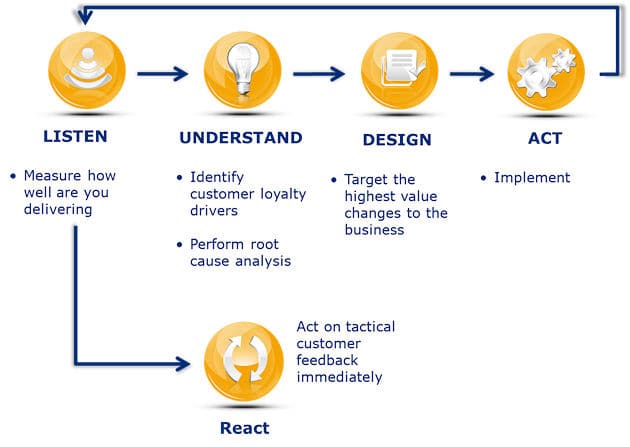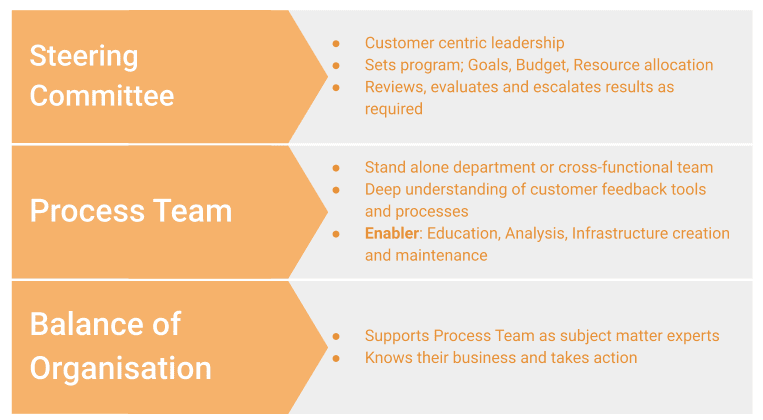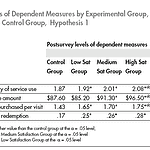When implementing a customer feedback program sending out surveys is a necessary but not sufficient condition for success. To to be successful you to drive change in the organisation using customer feedback information and it’s not always easy.
It takes effort, it takes perseverance and it takes a focus on change management. Critical to success is a customer feedback governance process for your organisation.
I know, governance is boring and nobody wants to talk about it. But governance is the place that we find many organisations fail in their customer feedback process.
In this post we’ll review the elements of the customer feedback cycle and the governance model that supports it.
The Customer Feedback Cycle

As a refresher, let’s review the closed loop customer feedback cycle.
Step 1: Listen
Measure how well you’re delivering through collecting customer feedback. Pretty much everybody is doing this step.
Step 2: React
What might surprise you is the second most-important part of the process is the React process, also called the service recovery process.
Are you running proactive service recovery based on customer survey feedback? If not you should be because it’s very valuable, but that’s for a post on another day.
Step 3: Understand
Root cause analysis is a big part of this step. When you get six months down the customer feedback track, you kind of lose the excitement about feedback. It becomes “okay; what do we do next? How do we make a big change?”
To do that you need to understand what drives customer loyalty and that’s what Understand is all about.
Step 4: Design
This is where you start to design the changes you want to make in your business.
Step 5: Act
This is the last but most important step. Without Act there is no reason to even collect customer feedback or do any of the other steps.
Governance Model
When I talk to most new clients they want to start with Listen and React but best practice is to hold off on that and start by deciding how you’re going to use the information.
So don’t start by running a customer survey. Use that first wave of energy part to get everybody engaged in the process with a solid governance process.
This is the governance model we use with organisations.

Steering Committee
It starts with a Steering Committee which includes the CEO, COO, head of business, whoever it is; it starts at the level in the organisation with complete ownership.
The Steering Committee meets maybe once a quarter but it is critical in setting the direction; the goals, the budgets, allocating staff, etc to the customer feedback process. They are not concerned with the detail of how data is collected but they do care how that data is being used to drive change.
They’re the people you go to when you want to get approval for the new project, to change how your business operates, etc.
At your company they are the senior management group and already exist in your organisation. Approach them and get them engaged in the process through enrolling them in the Steering Committee.
Process Team
The group that probably doesn’t exist at the moment is what we call the Process Team. Their role is critical to your success.
This is a mid-tier group of people in the organisation who have the job of understanding and running the customer feedback process on a day-to-day basis.
In some organisations this is a stand-alone department. I much prefer to have a cross-functional group: a member from the call centre, someone from operations, shipping, etc. A person from all the different groups that are actually touched by the Process Team.
In the cross functional approach it is not their whole job. This is one day a week, maybe it’s two days a week but it’s something they come together and work through as a team.
Their goal is to enable the customer feedback process through the rest of the organisation. They have the responsibility for the care and feeding of the data collection infrastructure. They have a deep understanding of customer feedback, or Net Promoter® if that is being used.
They understand how the process works and help everybody else to use the information most effectively.
An analogy I use is the Accounting Department. The accounting department don’t make sales or ship products but they understand money: they count it, they report on it and they know how to use it most effectively.
The Process team count customer feedback, report on it and know how to use it, but the balance of the organisation makes the changes. So these two, the Process Team and the balance of the organisation need to be very closely aligned. They’re the two groups that work together to understand what customers want and make changes in the business. This is also why it is so useful to have cross functional members on the Process Team. It helps to build the links with the rest of the company.
Lastly, the Process Team is the key to success of the customer feedback process. When we implement this process for our clients we recommend that they make the members of the Process Team the key focus of the whole game. Make the Process Team an aspirational group. In every company it should be a group that everyone wants to join, not just because they get visibility from senior management, through the Steering Committee, but because they are making things happen.
Why The Process Team Must be Cross-Functional
Involving stakeholders from different departments when building a customer experience process is important for several reasons:
- Holistic perspective: Different departments have different perspectives on the customer experience, and involving them ensures that the customer experience process is comprehensive and holistic. This helps to avoid silos and ensures that the customer experience is consistent across different touchpoints and departments.
- Better understanding of customer needs: Stakeholders from different departments bring diverse experiences and knowledge of customer needs. By involving them, organizations can gain a better understanding of customer needs and preferences, which is essential for creating a customer-centric experience.
- Improved collaboration: Collaboration between different departments is critical for creating a seamless customer experience. By involving stakeholders from different departments, organizations can ensure that there is alignment and collaboration across different touchpoints and functions.
- Identification of pain points: Involving stakeholders from different departments can help to identify customer pain points in the customer experience that might not be apparent to a single department. This allows organizations to address these pain points and improve the overall customer experience.
- Innovation: Involving stakeholders from different departments can lead to innovation and creative solutions. By bringing together diverse perspectives and expertise, organizations can develop new and innovative ways to improve the customer experience.
Overall, involving stakeholders from different departments when building a customer experience process is essential for creating a comprehensive and customer-centric experience. It leads to better collaboration, a more holistic understanding of customer needs, and can help to identify pain points and drive innovation.
Common FAQs on Customer Feedback Governance
Governance is the process of managing and making decisions about customer feedback. It’s important because without it, organizations may not use feedback effectively to drive change. Unfortunately, it’s often overlooked because it can be seen as boring, but it’s critical to the success of any customer feedback program.
The Steering Committee is a group of senior management that sets the direction and goals for the customer feedback process. The Process Team is a mid-tier group responsible for running the feedback process on a day-to-day basis. The two groups work together closely to understand customer needs and make changes in the business.






